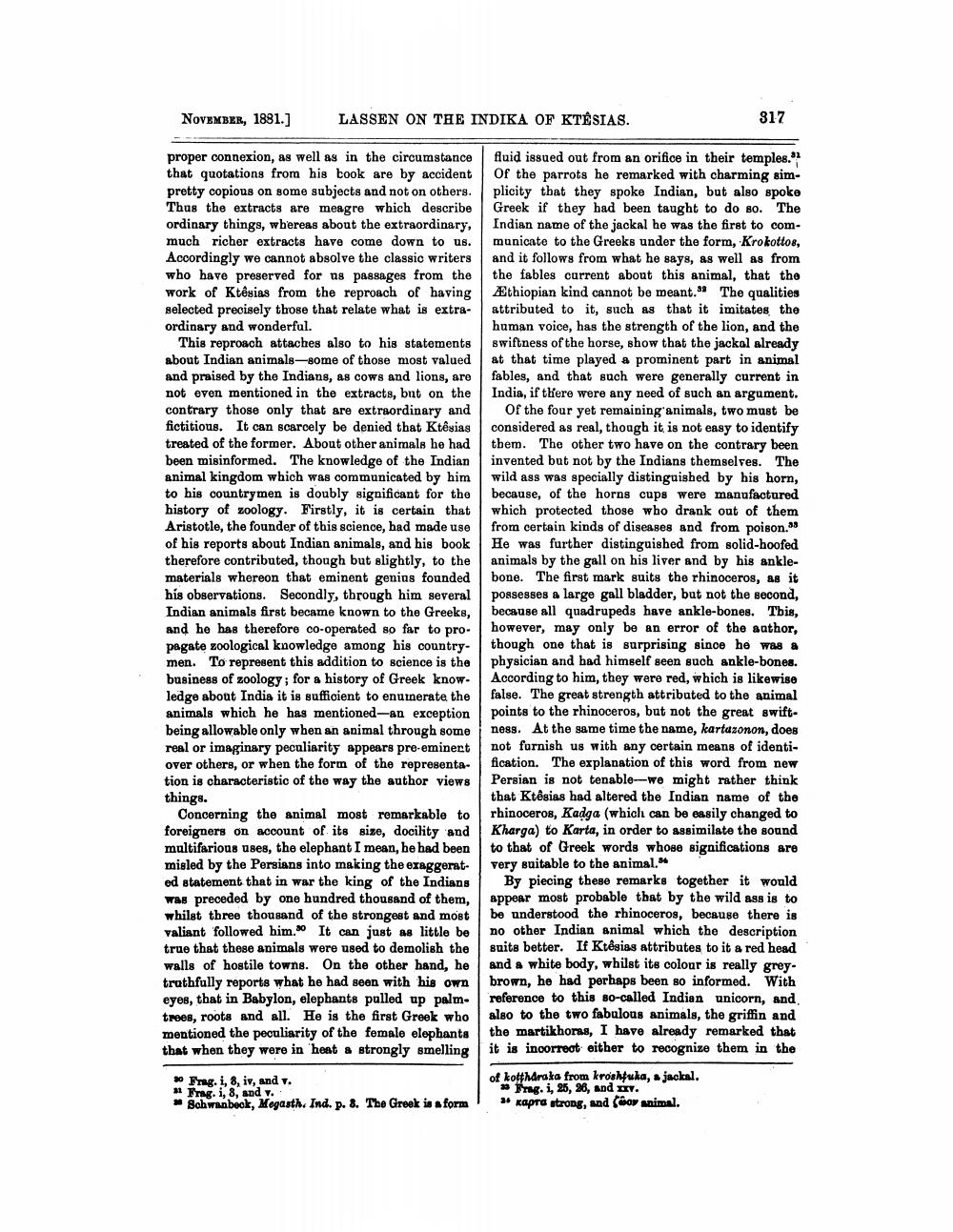________________
NOVEMBER, 1881.]
LASSEN ON THE INDIKA OF KTÉSIAS.
317
proper connexion, as well as in the circumstance that quotations from his book are by accident pretty copious on some subjects and not on others. Thus the extracts are meagre which describe ordinary things, whereas about the extraordinary, much richer extracts have come down to us. Accordingly we cannot absolve the classic writers who have preserved for us passages from the work of Ktesias from the reproach of having selected precisely those that relate what is extraordinary and wonderful.
This reproach attaches also to his statements about Indian animals-some of those most valued and praised by the Indians, as cows and lions, are not even mentioned in the extracts, but on the contrary those only that are extraordinary and fictitious. It can scarcely be denied that Ktêsias treated of the former. About other animals he had been misinformed. The knowledge of the Indian animal kingdom which was communicated by him to his countrymen is doubly significant for the history of zoology. Firstly, it is certain that Aristotle, the founder of this science, had made use of his reports about Indian animals, and his book therefore contributed, though but slightly, to the materials whereon that eminent genias founded his observations. Secondly, through him several Indian animals first became known to the Greeks, and he has therefore co-operated so far to pro- pagate zoological knowledge among his countrymen. To represent this addition to science is the business of zoology; for a history of Greek knowledge about India it is sufficient to enumerate the animals which he has mentioned-an exception being allowable only when an animal through some real or imaginary peculiarity appears pre-eminert over others, or when the form of the representa tion is characteristic of the way the author views things.
Concerning the animal most remarkable to foreigners on account of its size, docility and multifarious uses, the elephant I mean, he had been misled by the Persians into making the exaggerated statement that in war the king of the Indians Was preceded by one hundred thousand of them, whilst three thousand of the strongest and most valiant followed him. It can just as little be true that these animals were used to demolish the walls of hostile towns. On the other hand, he truthfully reports what he had seen with his own eyes, that in Babylon, elephants pulled up palm- trees, roots and all. He is the first Greek who mentioned the peculiarity of the female elephants that when they were in 'heat & strongly smelling
fluid issued out from an orifice in their temples. of the parrots he remarked with charming simplicity that they spoke Indian, but also spoke Greek if they had been taught to do so. The Indian name of the jackal he was the first to communicate to the Greeks under the form, Krokottos, and it follows from what he says, as well as from the fables current about this animal, that the Æthiopian kind cannot be meant." The qualities attributed to it, such as that it imitates the human voice, has the strength of the lion, and the swiftness of the horse, show that the jackol already at that time played a prominent part in animal fables, and that such were generally current in India, if there were any need of such an argument.
of the four yet remaining animals, two must be considered as real, though it is not easy to identify them. The other two have on the contrary been invented but not by the Indians themselves. The wild ass was specially distinguished by his horn, because, of the horns cups were manufactured which protected those who drank out of them from certain kinds of diseases and from poison." He was further distinguished from solid-hoofed animals by the gall on his liver and by his anklebone. The first mark suits the rhinoceros, as it possesses a large gall bladder, but not the second, because all quadrupeds have ankle-bones. This, however, may only be an error of the author, though one that is surprising since he was a physician and had himself seen such ankle-bones. According to him, they were red, which is likewise false. The great strength attributed to the animal points to the rhinoceros, but not the great swiftness. At the same time the name, kartusonon, does not furnish us with any certain means of identification. The explanation of this word from new Persian is not tenable--we might rather think that Ktêsias had altered the Indian name of the rhinoceros, Kadga (which can be easily changed to Kharga) to Karta, in order to assimilate the sound to that of Greek words whose significations are very suitable to the animal.**
By piecing these remarks together it would appear most probable that by the wild ass is to be understood the rhinoceros, because there is no other Indian animal which the description suits better. If Ktégias attributes to it a red head and a white body, whilst ite colour is really grey. brown, he had perhaps been so informed. With reference to this so-called Indian unicorn, and also to the two fabulous animals, the griffin and the martikhoras, I have already remarked that it is incorrect either to recognize them in the
* Frag. i, 8, iv, and v.
Frag. i, 8, and v. * Schwanbook, Megasth. Ind. p. 8. The Greek is a form
of kottharaka from kroshtuka, a jackal.
* Frag. i, 25, 26, and my. "kapra strong, and coor animal.




